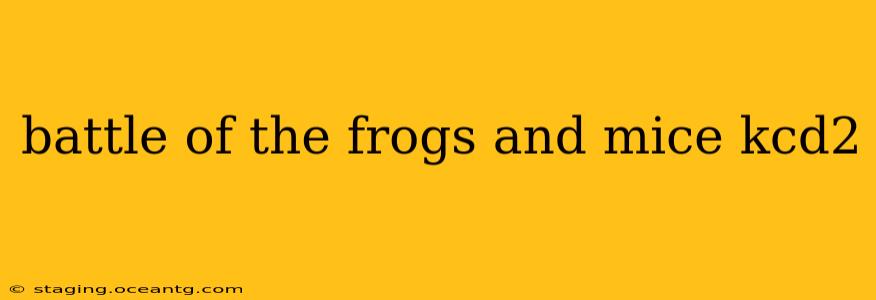The fable of the Frogs and the Mice, a cornerstone of Aesop's collection, resonates even today, offering timeless lessons about power dynamics, alliances, and the consequences of rash decisions. This exploration delves into the narrative itself, its interpretations within the context of The Complete Fables of Aesop, specifically referencing KCD2 (likely referring to a specific edition or collection), and its enduring relevance in modern society.
What is the Story of the Frogs and the Mice?
The core narrative centers on a precarious peace between two warring factions: frogs and mice. Initially, the frogs, larger and seemingly more powerful, hold sway. However, after suffering losses, the frogs seek an alliance with the mice. This alliance is initially successful, providing a period of relative calm. However, the peace proves fragile. The specifics of the conflict's resurgence and ultimate outcome vary slightly depending on the specific rendition of the fable, but the central themes remain consistent. The tale often concludes with a stark reminder about the dangers of unbalanced power and the instability of uneasy alliances.
What are the Moral Lessons of the Frogs and Mice Fable?
The fable's enduring power lies in its multifaceted moral lessons. It serves as a cautionary tale against:
- Overestimating Strength: The frogs' initial dominance blinds them to the potential strengths of their adversaries. Their arrogance leads to their eventual downfall, highlighting the importance of humility and strategic thinking.
- Underestimating Weakness: Conversely, the mice's apparent weakness is deceptive. Their cunning and adaptability allow them to initially prevail in their conflict with the frogs. The fable emphasizes the need to assess all potential threats seriously, regardless of their perceived power.
- The Fragility of Peace: The fleeting nature of the frog-mouse alliance demonstrates the inherent instability of peace built on uneasy compromises rather than mutual respect and genuine understanding.
- The Dangers of Blind Alliances: The hasty alliance formed by the frogs underscores the risk of joining forces without carefully considering the potential drawbacks and implications of such partnerships.
How Does the Battle of the Frogs and Mice Relate to Real-World Scenarios?
The fable's relevance transcends its simple animal narrative. The struggle between the frogs and mice mirrors numerous real-world power struggles and conflicts, both on a personal and a global scale. We see parallels in:
- International Relations: The story echoes the dynamics of international alliances, where seemingly powerful nations can be humbled by smaller, more agile adversaries.
- Business Competitions: Corporate mergers and partnerships often reflect the uncertainties and potential pitfalls of merging disparate entities, sometimes resulting in a struggle for dominance rather than mutual success.
- Social Dynamics: The tale can even be interpreted as a reflection of social hierarchies and power imbalances within groups or communities.
What are Different Interpretations of the Frogs and Mice Fable?
Interpretations of the Frogs and Mice fable vary across different editions and cultural contexts. Some versions emphasize the consequences of unchecked ambition, while others focus on the importance of strategic alliances. The specific details of the conflict and its resolution might differ subtly between versions like those found in KCD2 and other collections, yet the overarching themes of power, alliance, and the unpredictable nature of conflict remain central to the narrative's impact.
Why is the Battle of the Frogs and Mice Still Relevant Today?
The enduring relevance of the Frogs and Mice fable stems from its timeless exploration of fundamental human experiences: the pursuit of power, the challenges of cooperation, and the ever-present possibility of conflict. Its simple yet profound message continues to resonate with readers across generations, prompting reflection on our own relationships with power, alliances, and the unpredictable nature of conflict.
This detailed analysis hopefully provides a thorough understanding of Aesop's fable of the Frogs and Mice, particularly considering the context implied by KCD2. The enduring popularity of this story speaks to its enduring wisdom and its continued capacity to offer valuable insights into human behavior.
